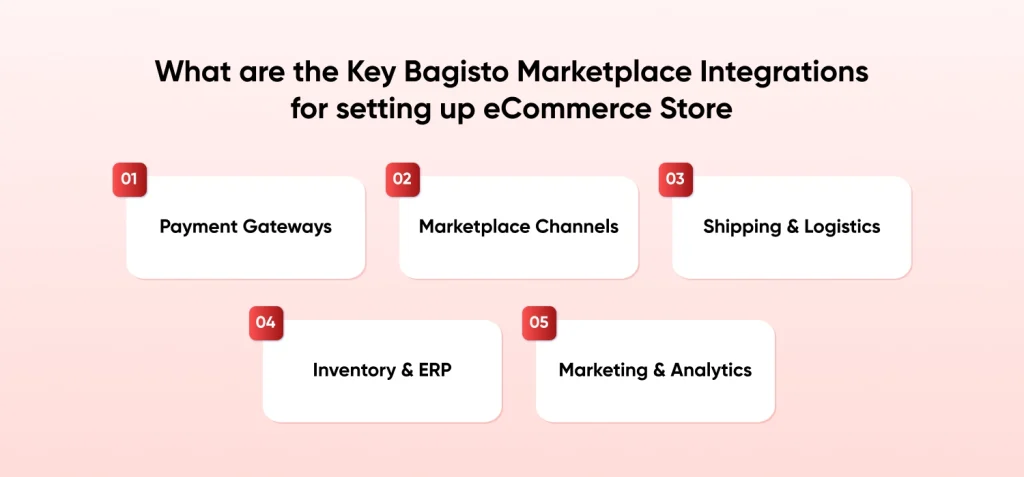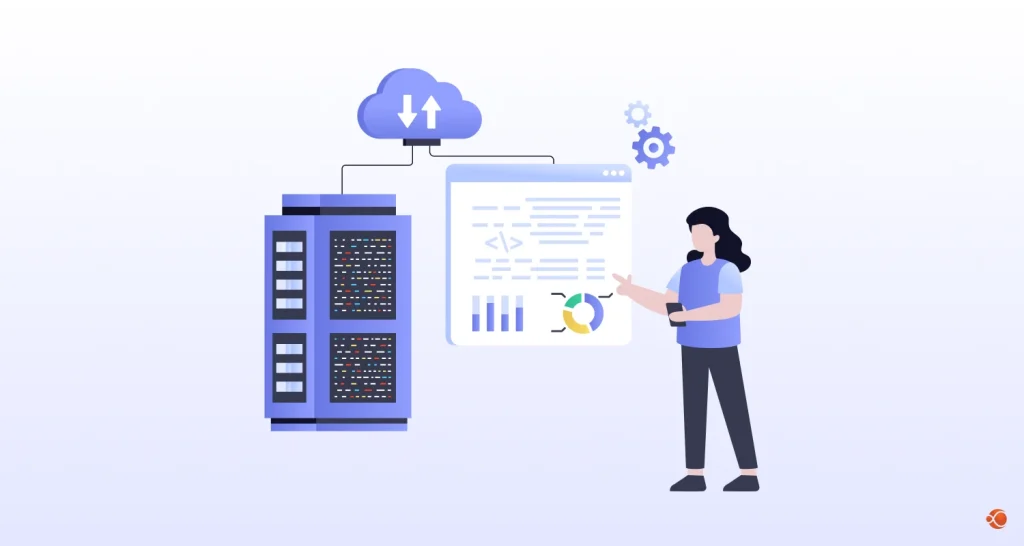Quick Summary: This step-by-step guide on how to build an eCommerce website using Bagisto, covers setup, store customization, multi-vendor options, and key integrations. Ideal for B2B, mobile, or subscription models, Bagisto offers full control with Laravel flexibility. Learn how you can use it for your next e-commerce project.
Launching an eCommerce site today requires more effort than picking a template and adding products, and deploying the site. You need a platform that provides flexibility, scalability, developer-friendly features, and cost-efficient options. This is where Bagisto Laravel for eCommerce stands out. It is an open-source, modular, and customizable eCommerce platform for businesses looking for complete control over their enterprise systems.
Whether you are a Laravel developer looking to build custom eCommerce features, or a business owner wanting to escape the vendor-lock in dependencies of SaaS platforms like Shopify or BigCommerce, Bagisto gives you the tools for creating a fast, highly customizable, and scalable eCommerce storefront, that can be configured to your requirements. Today, we will walk you through how to build an eCommerce website using Bagisto, covering system requirements, configuration, customization, and launch-ready best practices. We will also cover some alternative Laravel eCommerce packages.
What is Laravel Bagisto?
Bagisto is a popular, open-source Laravel eCommerce platform. According to BuiltWith, over 1.5k websites use Bagisto across various industries. The main principle guiding Bagisto is providing complete control and freedom in how an eCommerce store functions. It provides various features and functionalities, search engine management, and also store management. With Bagisto, merchants can set up their shopping cart systems with all assets, in a quick time. It’s an ideal foundation if you’re looking to build an eCommerce website using Bagisto that’s modular and future-ready.
Key Ecommerce Capabilities of Bagisto
- Multi-currency support
- Multi-store inventory management
- Product SEO tools
- Various access and authentication levels
- Custom product attributes
- Order management system
- Intuitive GUI for admin and customers
- Support for various extensions
- Bagisto as PWA (Progressive Web Application)
Why Build an eCommerce Website using Bagisto?
For any eCommerce platform, its success does depend on the foundation platform it is built on. While the storefront needs to be appealing with great UI/UX, you also need backend capabilities, control, flexibility, and provisions to scale and change the marketplace as per the changing needs. Look for eCommerce website development services that know how to use Laravel Bagisto, as it offers all of these services, plus it’s an open-source free to use platform.
Key Reasons to Choose and Customize Bagisto for eCommerce Projects
| Feature | What It Offers |
| Full Ownership and Control | Open-source codebase lets you fully control and customize every part of the platform. |
| Built with Laravel | Uses Laravel’s ecosystem (Blade, Eloquent, Artisan) making it easy for developers to work with. |
| Modular Architecture | Each feature is built as a module, so you can add, remove, or customize components easily. |
| Multi-Store and Multi-Vendor | Manage multiple storefronts or marketplaces under one backend with centralized control. |
| PWA and Mobile Ready | Supports Progressive Web Apps for faster, mobile-optimized shopping experiences. |
| SEO and Performance Optimized | Comes with SEO tools and a clean codebase to help you rank higher and load faster. |
| Active Community and Extensions | Strong developer support and a growing ecosystem of plugins and modules for easy expansion. |
How to Build an eCommerce Website Using Bagisto and Laravel?
Step 1: Prepare Your System
These requirements are the foundation for anyone wanting to build an eCommerce website using Bagisto without hitting compatibility issues.
- PHP 8.1 or higher
- Composer 2.5 or higher
- MySQL 8.0.32+ or MariaDB 10.3+
- Node.js 18.12.0 LTS or above
- Apache 2 or NGINX web server
- At least 4 GB RAM recommended
Step 2: Install Bagisto via Composer
Open your terminal and run the following commands to set up Bagisto from scratch. If you’re starting from scratch to build an eCommerce website using Bagisto, this is the cleanest way to do it.
bash
# Choose your working directory, then run:
composer create-project bagisto/bagisto
# Move into the new project folder:
cd bagistoStep 3: Configure Environment
bash
# Copy the example environment file:
cp .env.example .envOpen .env in preferred text editor and update the database settings:
text
APP_URL=http://localhost:8000
DB_CONNECTION=mysql
DB_HOST=127.0.0.1
DB_PORT=3306
DB_DATABASE=bagisto_db
DB_USERNAME=root
DB_PASSWORD=your_password_hereReplace bagisto_db, root, and your_password_here with your actual database name and credentials. Make sure the database exists.
Step 4: Install Dependencies and Generate App Key
bash
# Install PHP dependencies:
composer install
# Generate Laravel application key:
php artisan key:generateStep 5: Run Database Migrations
bash
php artisan migrateThis sets up the necessary tables in your database.
Step 6: Seed the Database (Create default data)
bash
php artisan db:seedThis seeds default admin user and initial configuration.
Step 7: Build Frontend Assets (Optional for custom UI development)
bash
npm install
npm run devThis compiles frontend assets like CSS and JS for Bagisto’s UI.
Step 8: Serve the Application Locally
bash
php artisan serveYour Laravel web application will be accessible at:
text
http://localhost:8000Alternatively, configure your web server’s document root to point to:
text
your-project-root/publicStep 9: Access Admin Panel and Start Configuration
- Open http://localhost:8000/admin in your browser.
- Login with default admin credentials:
text
Email: admin@example.com
Password: admin123Important: Change your admin password immediately after logging in.
Step 10: Configure Your Store
From the admin dashboard, do the following:
- Set store Channels, Locales, Currencies (Stores > Channels)
- Create Categories (Catalog > Categories)
- Add Products (Catalog > Products)
- Configure Payment Methods and Shipping Methods (Settings > Payment Methods, Shipping Methods)
- Set up Tax Rules if applicable
- Adjust other settings like SEO, emails, etc. as needed

Why Choose Bagisto Over Other Laravel eCommerce Frameworks?
| Feature | Bagisto | Aimeos | Vanilo |
| Built on Laravel | Yes | Yes | Yes |
| Admin Panel | Ready-to-use Vue.js UI | Requires custom build | Minimal UI, build your own |
| Modular Architecture | Highly modular | Microservices-based | Component-based |
| Multi-Vendor Support | Built-in | Available via extension | Not supported out of box |
| Multi-Store Management | Yes | Advanced | No |
| Custom Product Types | Simple, configurable | Complex, nested types | Basic support |
| PWA Support | Out of the box | Not available | Not available |
| API Access | RESTful APIs | Extensive API coverage | REST and GraphQL |
| Community & Ecosystem | Large, growing | Smaller, enterprise-focused | Niche, dev-centric |
| Learning Curve | Medium | Steep | Medium |
| Best For | Startups, SMEs, Agencies | Enterprise-scale eCommerce | Custom Laravel apps |
There are many blogs comparing Amieos vs Vanilo vs Bagisto. They are the top three Laravel eCommerce website packages, and all of them are outstanding in their own right. Aimeos is built for complex high-scale enterprise applications.It demands more initial learning, and requires more setup for implementing basic features.
Vanilo is a lean and flexible Laravel ecommerce package, that is ideal for developers who like building a highly customizable eCommerce solution from scratch. But when you build eCommerce website with Bagisto, you get a platform that strikes a perfect balance. It has many strong features out-of-the-box, including a complete admin panel, PWA capabilities, and the ability to set up multi-vendor eCommerce with Bagisto is also impressive. With so many features already available, the platform still allows customization at the code level.
What are the Common Use Cases and Industry Applications of Bagisto Laravel eCommerce Website
B2B Marketplaces
Bagisto provides many features like shared catalogs, custom pricing, and quick order functionality that are needed in a B2B environment. Businesses can look for professional laravel web development services that can set up role-based access controls, assign roles, control buyer groups, and manage bulk ordering effectively.
Multi-Vendor Marketplaces
It is very easy to set up Bagisto marketplace integration. Generally, you would need to undergo a tedious process of setting up the code infrastructure to create an ecommerce marketplace like Amazon or Etsy. With Bagisto, you can simply use the official Laravel Multi Vendor Marketplace extension. It provides vendors with individual dashboards, product management tools, and order tracking features that can be centrally managed by the store admin.
What makes it even more efficient is how laravel routing is used under the hood to cleanly separate admin, vendor, and customer routes. This keeps the codebase organized and makes it easier to implement features like vendor-specific dashboards, route guards, and API endpoints for different roles
Subscription-Based Commerce
The world of SaaS products, and product offerings are shifting from one-time purchase pricing to subscription-based commerce. If you want to build a commerce website with recurring billing models, digital subscriptions, or even different service plans, Laravel Bagisto opens the door to SaaS commerce, subscription boxes, and premium memberships.
Mobile Commerce and PWA Development
Today, mobile-first is not just a preference, it is an absolute requirement. Bagisto is a headless Laravel-based eCommerce platform that enables developers to build custom mobile apps using Bagisto with Flutter or React Native. For those who want faster go-to-market deployment, Bagisto also supports Progressive Web Applications. Most companies looking for eCommerce website development services look for PWA compatibility.
Building a PWA ecommerce store provides many benefits like ability to work offline, apps load quickly, and also support for push notifications. The users can use your web app with native app-like experience without ever downloading any app. Bagisto mobile ecommerce helps expand the user base to areas with limited bandwidth.
Global eCommerce with Multi-Currency and Multi-Lingual Support
Build an eCommerce website using Bagisto for tapping international markets. Bagisto provides built-in localization features which is a great asset for global eCommerce businesses. It also supports multiple currencies, so converting prices to match the local currency makes it easier for customers from different countries to interact and make transactions on your storefront. With this capability, you can scale brands to European, the Middle East and APAC markets with ease.
What are the Key Bagisto Marketplace Integrations for Setting up eCommerce Store?

When you build an eCommerce website using Bagisto, these integrations dont remain optional. From payments and logistics to ERP and analytics, Bagisto’s ecosystem helps you automate and scale faster. These integrations save development time, improve workflows, and help scale your eCommerce business faster. Build an eCommerce website using Bagisto integrations such as:
Payment Gateways
- PayPal – Supports standard and Express Checkout, multi-currency, refund handling, and auto payment notifications.
- Stripe – Offers one-click checkout, subscriptions, fraud detection, 3D Secure, and webhook-based status updates.
- Razorpay – Ideal for India: UPI, net banking, wallets, cards, instant settlements, and analytics.
- PayU & CCAvenue – Target Asian markets with local methods, multi-currency support, and low transaction fees.
Marketplace Channels
- Amazon – Sync products, inventory, pricing, and orders; includes real-time updates and auto-fulfillment.
- eBay – Bulk listings, inventory sync, fixed-price/auction support, and automated repricing.
- Facebook Shop – Link your catalog, handle social orders, and track Instagram/Facebook conversions.
- Google Shopping – Sync product feeds, manage ads, support dynamic remarketing and campaign tracking.
Shipping & Logistics
- FedEx & UPS – Real-time rates, labels, tracking, customs support, and delivery alerts.
- DHL – Pickup scheduling, insurance, and international multi-piece shipping.
- Local Carriers – Integrations for Delhivery, Blue Dart, Royal Mail, and others with regional advantages.
Inventory & ERP
- SAP Business One – Enterprise-level sync of customers, products, inventory, and transactions.
- Zoho Suite – Automate CRM, inventory, and financial workflows with Books, CRM, and Inventory.
- QuickBooks – Sync sales, customer info, and taxes with both Online and Desktop versions.
Marketing & Analytics
- Mailchimp – Automated emails, customer segmentation, and cart recovery campaigns.
- Google Analytics & Tag Manager – GA4 support, eCommerce tracking, conversion goals, funnel analysis.
- HubSpot CRM – Centralized lead tracking, marketing automation, and customer journey insights.
Why Outsourcing Laravel Development to CMARIX is Your Best Choice?
We at CMARIX have a large team of experienced Laravel developers. Our professional Laravel developers have worked on various client projects across the globe, and belong from various industries. We are one of the most preferred companies for outsourcing Laravel development in the US, the UK and other markets. Here is what makes us stand out from the competition:
1. Deep Laravel Expertises Across Domains
Our Laravel developers have built many marketplace solutions and SaaS products. We have also worked on custom CRMs and portal development for many clients. Whether you want to build a scalable multi-vendor marketplace or integrate complex APIs, we have already done it various times, across different sectors.
2. Dedicated Teams with Flexible Hiring Models
We offer flexible hiring models for helping clients hire dedicated Laravel developers as per their project requirements and scale. Whether you hire full time Laravel developers or opt for hourly hire, we provide benefits such as zero charges for a project manager to overlook the process, daily progress updates with code releases, time-zone aligned collaboration, exclusive developer allocation, rapid onboarding and more.
3. Complete Project Ownership
Our developers are ready to work as per your time-zone, utilize your preferred tools, and provide full control over how your projects are managed. CMARIX Laravel developers are an extension of your team, working towards bringing your idea to code, and life.
4. Full-Cycle Development, Not Just Coding
CMARIX is your one-stop trusted software development service provider. From UI/UX designing and architecture planning, to QA, DevOps and post-launch support, our team will handle every aspect of your laravel web application development project.
Final Words
To build an eCommerce website using Bagisto isn’t just about choosing the right technology. It’s a smart, strategic move for your business. With Bagisto, you get complete control over how your store looks, functions, and grows.
What really sets it apart is how easily it connects with the tools you depend on, like payments, ERP, inventory, shipping, and analytics. There are no rigid workflows or vendor lock-ins. Just the flexibility to build a system that fits your business.
If you’re looking to simplify your tech stack and bring everything together with powerful Laravel integrations, this is the right time. Get in touch with the team at CMARIX. We’ll help you build an eCommerce setup that is scalable, secure, and ready for what’s next.
FAQs on Using Bagisto for Ecommerce Development
What Is Bagisto and How Does It Relate to Laravel?
Bagisto is a free, open-source e-commerce platform built on the Laravel PHP framework. Because it’s built on Laravel, it benefits from Laravel’s security best practices and reliable structure. This makes it easy to scale as your business grows. It uses Laravel tools like Eloquent for handling data, Blade for designing pages, and Laravel’s routing system to manage how the app responds to users. This setup gives developers a flexible and powerful way to create online stores and take advantage of Laravel’s huge ecosystem.
How to Develop an Online Store Using Bagisto?
To develop an online store with Bagisto, first install it via Composer or download from GitHub, then configure your database and run migrations. Users can make use of the admin panel to set up store configuration, add products, categories, and customize themes. The platform provides out-of-the-box features for inventory management, order processing, and customer management, allowing you to launch quickly with minimal custom development.
Can I Use Bagisto for a Multi-Vendor Marketplace?
Yes, you can! Bagisto offers a marketplace extension that lets you turn your store into a multi-vendor platform. This means multiple sellers can sign up, add their own products, manage orders, and get their own dashboards. Meanwhile, you stay in control of the whole platform with tools like commission management and seller approvals.
Can I Integrate Payment Gateways With Bagisto?
Absolutely. Bagisto supports major payment gateways like PayPal, Stripe, and Razorpay right out of the box. If you need others, you can either build your own payment module or use plugins made by the community. Thanks to its modular setup, adding new payment options is pretty straightforward.
How Scalable Is Bagisto for Growing Businesses?
Bagisto is built to grow with you. Its Laravel core supports features like caching (with Redis), database optimization, and horizontal scaling, so it can handle large product catalogs and heavy traffic. For even bigger operations, you can use load balancing, database clustering, and CDNs to boost performance and reliability.







